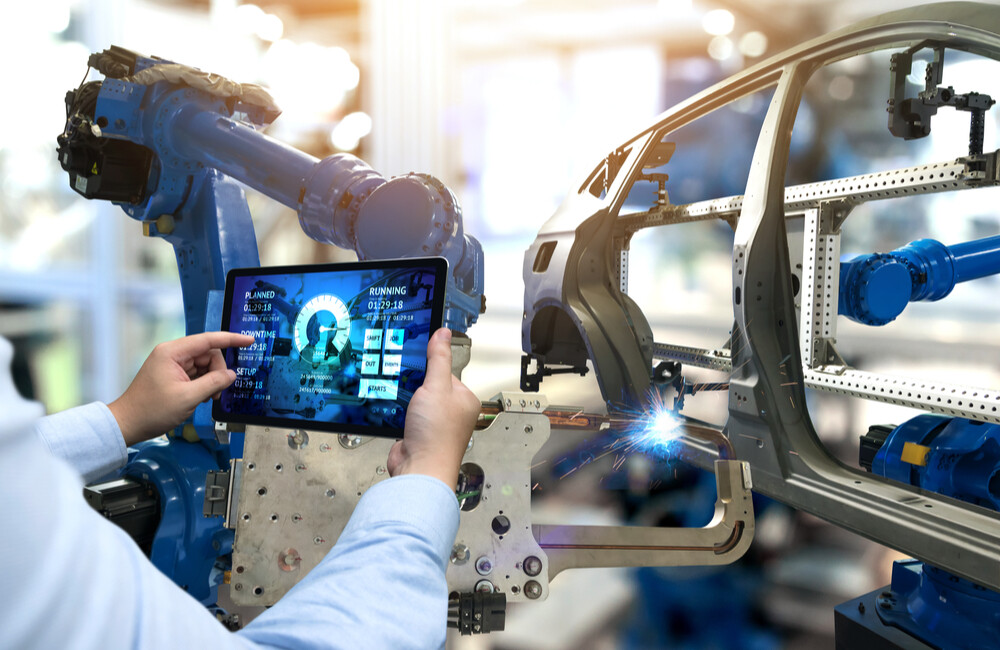Media reports around technology and data science are sometimes a blizzard of hyperbole, exaggeration and “pie in the sky” predictions. For example, weren’t drones going to deliver every package to our door by now? Shouldn’t we all be able to talk to our houses and cars at this point, and they’ll answer back? And speaking of cars, why isn’t yours already driving itself?
That’s not to say all those things won’t eventually happen. But a “Jetsons”-type future, much less a “Star Trek” one, remains many years away. You’ll just have to wait on that jetpack.
This exposure to so many bold predictions explains why some might shake their heads and roll their eyes at the term “4th Industrial Revolution.” Weren’t we just calling this the Information Age? However, for those earning an online data science degree, it’s important to understand the major components of this 4th Industrial Revolution. That’s because it’s already happening, and you will eventually work right in the middle of it.
People, Get Ready
Since about 2016, a flurry of media reports, videos, academic papers and TV pundits began speaking of the 4th Industrial Revolution. People have been told it’s time to get ready for it.
But what exactly does that mean? Generally defined, the 4th Industrial Revolution involves the integration of digital, physical and biological systems. These cyber-physical systems have become possible through the Internet of Things (IoT), machine learning, and advances in biotechnology.
The goals of the revolution are lofty. But an Online Data Science Degree can help you prepare.
Speaking for a video on the topic for the World Economic Forum, Stewart Wallis of the New Economics Forum in London said, “We need a different economic model that will allow us to meet the basic needs of every human on the planet. And there will be a focus not on growth, per se, but on maximizing human well-being.”
That’s what makes the ideas behind the revolution different than those of the first three. Rather than focusing on leveraging technology for profit, the idea is to implement technology to make life better. That includes areas such as healthcare, education, and transportation.
That last one is hard to imagine for those sitting on I-93 in Boston, stuck in traffic for the 1,000th time. But perhaps it’s uplifting to know the idea is being taken seriously by academics and business leaders around the world.
Facets of the Revolution
What are some of the specific areas where the 4th Industrial Revolution could make a difference? Some of these areas are already in motion and those seeking an online data science degree should pay attention. Others are further down the road.
They include:
- Automation in manufacturing. Advances in robotics and machine learning will only accelerate this process
- 3D printing. The ability to use a three-dimensional digital model to make a physical object could revolutionize many industries, especially healthcare
- Virtual reality. Already in use in gaming, but has applications in healthcare, training, education, museums and manufacturing
- Nanobots. These are used to fight disease and prevent illness by being injected directly into a patient’s bloodstream. Researchers in China have already used them to attack and destroy cancer cells in mice
- Artificial intelligence. Most often referred to for use in self-driving vehicles and in machines used for data collection and analysis
- Predictive analytics. Already in use in everything from baseball to digital marketing. For example, predictive analytics can tell organizations what products they need and when, how much inventory is required, how consumer behavior online predicts their purchasing decisions – just to name a few
The collection and analysis of data underpins all these innovations.
Potential Problems
The possible negative impact of the 4th Industrial Revolution is the same as every revolution that has come before: wealth inequality. Some believe it could lead to an upheaval in social and political institutions.
Here’s a summary of the first three revolutions:
First Industrial Revolution. In the late 18th and early 19th century, steam power and mechanization improved production and transportation and sparked a move away from an agrarian society.
Second Industrial Revolution. Scientists harnessed electrical power that led to an explosion in the steel and oil industries, as well as migration into cities to work in mass production factories. This era also included the invention of the combustion engine, airplanes and film.
Third Industrial Revolution. Beginning in the 1960s, invention and commercialization of computers for personal use opened the door to laptops, smartphones, tablets, and other technological advances. Creation of the Internet led to worldwide, instantaneous communication.
In these cases, a great deal of wealth was created, but concentrated near the top of the economic chain. It took decades of changes in political and social policy to give a larger percentage of the population a piece of the economic pie.
One of the chief concerns about the 4th Industrial Revolution is that it will result in fewer jobs, as has already started in manufacturing. Many note also that fewer workers are needed to create billion-dollar companies in Silicon Valley today as were needed in Detroit when assembly line car production flourished.
Some fear a continuation of the trend of increasing inequality in wealth distribution going forward. This was famously detailed in the book “Capital in the 21st Century” by French economist Thomas Piketty, of increasing inequality in wealth distribution going forward.
All that said, there are obviously many advantages to the use of cyber-physical systems. What’s more, past advances in technology have shown there is no stopping the continuation of innovation, no matter how disruptive. But if the past is prologue, public policy will catch up and institute needed changes.
Clearly, the 4th Industrial Revolution is both real and disruptive in ways that are not yet fully understood. For those seeking an online data science degree, however, it represents a rapidly expanding number of opportunities in many different fields.


